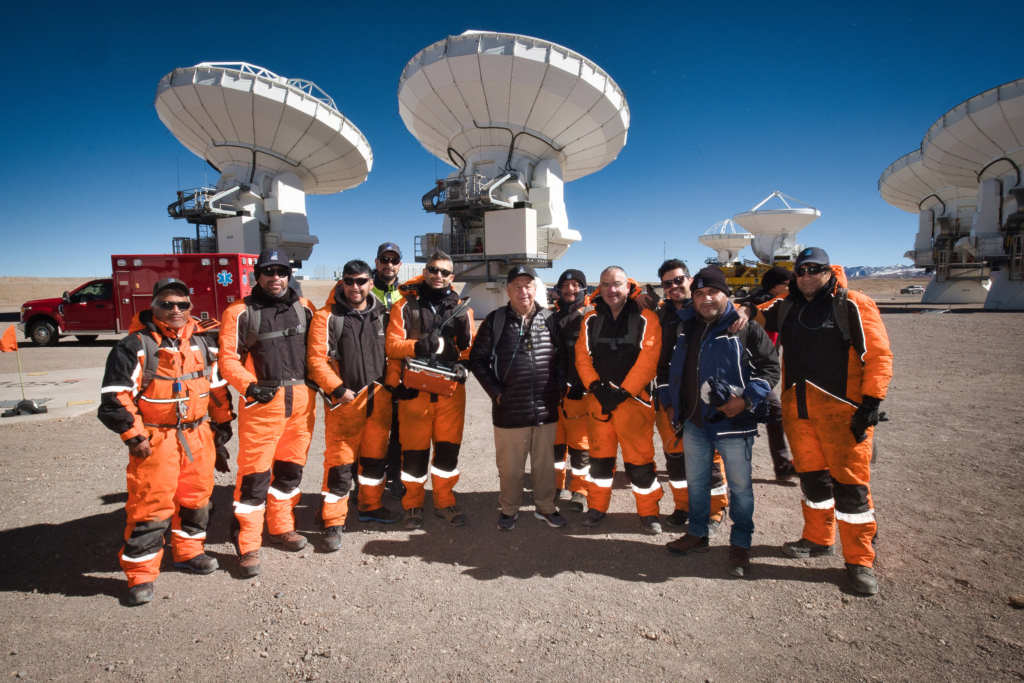New radio images from the the U.S. National Science Foundation Very Large Array trace a pair of powerful plasma jets launched by galaxy VV 340a’s central supermassive black hole, which appear to be driving hot coronal gas out of the galaxy and shutting down future star formation.
Recent News
Radio Telescopes Uncover ‘Invisible’ Gas Around Record-Shattering Cosmic Explosion
Astronomers using the U.S. National Science Foundation Very Large Array and the Atacama Large Millimeter/submillimeter Array have revealed a dense cocoon of gas around one of the most extreme cosmic explosions ever seen, showing that a ravenous black hole ripped apart a massive star and then lit up its surroundings with powerful X-rays.
New Discovery Challenges Evolution of Galaxy Clusters
Peering back in time, around 12 billion years, astronomers using the Atacama Large Millimeter/submillimeter Array (ALMA) have found the most distant and direct evidence of scorching gas in a forming galaxy cluster, SPT2349-56. The hot plasma, seen when the Universe was just 1.4 billion years old, is far hotter and more pressurized than current theories predicted for such an early system.
United Nations Secretary-General Visits ALMA

ALMA received a visit from UN Secretary-General António Guterres, who explored the array site high in Chile’s Atacama Desert. The antenna maintenance group crew, a key component of the Observatory’s operation, is seen in this picture alongside Guterres. Credit: ALMA (ESO/NAOJ/NRAO), R.Bennett
The Atacama Large Millimeter/submillimeter Array (ALMA), one of the largest and most sensitive telescopes of its kind in the world, received a visit from United Nations (UN) Secretary-General António Guterres, who had the opportunity to learn about how ALMA’s high-tech systems capture and combine signals from the cosmos. ALMA represents partnership between Europe (European Southern Observatory), North America (National Radio Astronomy Observatory) and East Asia (National Astronomy Observatory of Japan), along with the Republic of Chile. These nations worked together to create a scientific instrument that none of them could build on their own.
Chile has been called an astronomy paradise, and that’s why ALMA was constructed on the Chajnantor Plateau in the country’s Atacama Desert, one of the highest and driest places on Earth. This position provides a clear view of the southern sky, and the desert atmosphere is free from weather that would make ALMA’s millimeter and submillimeter observations impossible.
“As we prepare for the New Pact of the Future this September,” said Guterres, “It is important to recognize that science has the capacity to bring together nations to create transformational discoveries, like the international collaboration behind the imaging of Black Hole M87*, in which ALMA played a crucial role. This visit underlines that advancing human understanding of the Universe is essential to expand the benefits from science, technology and innovation as well as digital cooperation to close the gaps of our global development agenda.”
“NRAO is proud to be a part of ALMA. With support and oversight from the U.S. National Science Foundation and Associated Universities, Inc., we get to share the best of our astronomical resources with our staff in Chile and our partners. The UN and ALMA have much in common – both are a result of international collaboration in the hopes of sharing knowledge and resources that benefit all of humanity. We are honored by this visit from Secretary-General Guterres where we were able to show how this partnership mirrors the goals and efforts of the UN,” shares Paulina Bocaz, AUI Representative and NRAO Assistant Director for Chile.
About ALMA
The Atacama Large Millimeter/submillimeter Array (ALMA), an international astronomy facility, is a partnership of ESO, the U.S. National Science Foundation (NSF) and the National Institutes of Natural Sciences (NINS) of Japan in cooperation with the Republic of Chile. ALMA is funded by ESO on behalf of its Member States, by NSF in cooperation with the National Research Council of Canada (NRC) and the National Science and Technology Council (NSTC) in Taiwan and by NINS in cooperation with the Academia Sinica (AS) in Taiwan and the Korea Astronomy and Space Science Institute (KASI).
ALMA construction and operations are led by ESO on behalf of its Member States; by the National Radio Astronomy Observatory (NRAO), managed by Associated Universities, Inc. (AUI), on behalf of North America; and by the National Astronomical Observatory of Japan (NAOJ) on behalf of East Asia. The Joint ALMA Observatory (JAO) provides the unified leadership and management of the construction, commissioning and operation of ALMA.
This news article was originally published on the NRAO website on September 10, 2024.
Recent News
The NSF Very Large Array Helps Reveal Record-Breaking Stream of Super-Heated Gas from Nearby Galaxy
New radio images from the the U.S. National Science Foundation Very Large Array trace a pair of powerful plasma jets launched by galaxy VV 340a’s central supermassive black hole, which appear to be driving hot coronal gas out of the galaxy and shutting down future star formation.
Radio Telescopes Uncover ‘Invisible’ Gas Around Record-Shattering Cosmic Explosion
Astronomers using the U.S. National Science Foundation Very Large Array and the Atacama Large Millimeter/submillimeter Array have revealed a dense cocoon of gas around one of the most extreme cosmic explosions ever seen, showing that a ravenous black hole ripped apart a massive star and then lit up its surroundings with powerful X-rays.
New Discovery Challenges Evolution of Galaxy Clusters
Peering back in time, around 12 billion years, astronomers using the Atacama Large Millimeter/submillimeter Array (ALMA) have found the most distant and direct evidence of scorching gas in a forming galaxy cluster, SPT2349-56. The hot plasma, seen when the Universe was just 1.4 billion years old, is far hotter and more pressurized than current theories predicted for such an early system.
